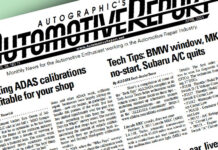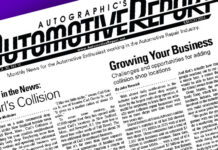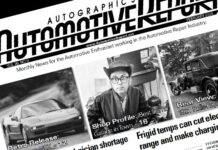Ten industry news items, trends and tools you may have overlooked this year.
By John Yoswick
As another year comes to an end, here are 10 bits of useful industry news that might have flown under your radar amid the day-to-day challenges of running your shop, but that could prove helpful for you to know about.
1) American Honda this past July issued a position statement that in part calls for vehicle seat weight sensors (or “occupant detection systems”) to be checked (via vehicle scan) after “any collision, regardless of damage, even if no airbags deployed.” Honda’s Chris Tobie says no dash light tells you such calibration is needed, but it is important because the system weighs the upper body of any front-seat passenger to notify the airbag system whether to deploy the passenger airbag based on the presence (and size) of a vehicle passenger.
“Basically it turns the seat into a bathroom scale,” Tobie said. “Would you throw your bathroom scale as hard as you could and expect it to weigh you accurately afterward? This scale is very sensitive. It’s a precision instrument. You don’t throw precision instruments into an impact and expect them to work.”
If not calibrated properly, Tobie said, “there’s a possibility [the vehicle] could deploy a front passenger airbag with a child in the seat, and the outcome would not be good.”
2) Also this past year, Honda’s Tobie echoed representatives from a number of automakers who have stressed the importance of looking up OEM collision repair procedures before every repair, because those procedures sometimes change even within a model year or between major design changes. He cited several examples.
“The 2014 Odyssey has 1,500 megapascal steel in it, whereas previously the car only had 780 megapascal in it,” Tobie said. “Same thing with the CR-V: The 2014 CR-V body stops at 780 megapascal; for 2015, all of a sudden, the sills and the front pillars are 1,500 megapascal. That totally changes the way you approach the repair. So if you just say, ‘This looks like the repair I did last week,’ it could be a very dangerous assumption and a very unsafe repair.”
3) Perhaps you’re heard about — or even have participated in — the quarterly “Who Pays for What” surveys being conducted by industry trainer and consultant Mike Anderson of Collision Advice in conjunction with CRASH Network (for which this writer is an editor). The surveys ask shops how regularly they are paid for “not-included” procedures by eight of the top national insurers.
But you might not have heard there are indications the surveys are having an impact in the industry. As the end of a second year of quarterly “Who Pays for What?” surveys approaches, Anderson said there are two ways to look for year-to-year trends in the results. One is to look for changes (up or down) in the percentage of shops that report that they are paid “always” or “most of the time” for the “not-included” operations asked about in the surveys. CRASH Network reported this fall that the most recently-released survey findings — looking at frame and mechanical procedures — show those percentages tend to be up.
The biggest improvement, for example, was among shops charging for “final verification of measurements” (a final check and print-out of frame measurements following completion of repairs) where nearly half (49 percent) of shops charging for this procedure are being paid “always” or “most of the time” from the eight largest insurers in the country. This is up 16.4 percentage points from a year earlier when only one-third of the surveyed shops reported being paid as regularly.
Anderson has said another trend he’d hoped to see in the surveys is a decrease in the number of shops who say they have “never” invoiced for the procedures when they are necessary and are done. There’s evidence in the 2016 frame and mechanical survey — compared to the same survey a year earlier — that that’s the case.
More repair facilities, for example, are charging for pre-repair vehicle scans. In fact, that procedure saw the largest decline in the percentage of shops who say they have “never asked” to be paid for the procedure, indicating that more shops are putting it on their estimates or supplements in 2016 than were in 2015. Overall, about one-in-three shops (35.6 percent) in 2016 said that performing a “health scan” of vehicle control modules is something they have never charged for, but that’s down more than 10 percentage points from last year when 46.3 percent said they’d never charged for it.
Collision repairers who want to sign up to take the next “Who Pays for What?” survey (in January), or get information from previous surveys, can visit: http://www.crashnetwork.com/collisionadvice
4) The agency that licenses collision repairers in California may not regulate shops elsewhere in the country, but some advice the California Bureau of Automotive Repair (BAR) offered shops in that state last summer might resonate for shops elsewhere.
Speaking at NACE in Southern California, BAR representatives said they think shops too often put themselves in the middle of discussions that consumers themselves should be having with their insurance company. The BAR representatives were asked about insurers refusing to pay for the pre- or post-repair scans that several automakers have called necessary in recently-released position statements.
“You as a shop owner need to take a step back and tell the consumer, ‘Your insurance company is not paying for this,’” Jaime Ramos of the BAR’s field operations and enforcement division suggested. “Tell them: ‘The manufacturer is saying we have to do it. In order to do it right, I need to do that. The insurance company is telling me ‘no.’ How would you like for me to proceed?’”
Ramos said he can appreciate shops trying to go to bat for their customers with insurance companies.
“But I guarantee you they have a little bit more leverage with their own insurance company than you do,” he said. “And if they don’t, then it’s their option. They can pay for it. Or you can document on the invoice that you requested to do it, the insurance did not want to pay for it, the consumer called the insurance company, and the consumer doesn’t want to pay for it either. Then if there’s any trouble codes in there, it’s going to be all on the consumer or the insurance company.”
Ramos said he couldn’t speak to the necessity of the scans.
“But certainly if a manufacturer found that there’s a need, that when you’re repairing a vehicle you should be doing that, I think that carries quite a bit of weight,” he said.
5) About a year after the Auto Care Association created an online job board for those seeking work — or wishing to post job openings — in the automotive aftermarket, the Society of Collision Repair Specialists (SCRS) announced its partnership on the project. SCRS said its goal is to help collision shops attract new employees and help “hard-working young technicians find their way to a rewarding career in the industry.”
The job board can be accessed through either association’s website, but using the www.scrs.com/jobs link appears to bring collision-related postings to the top of the job openings listed. Those seeking work can post their qualification information as well.
SCRS said it is reaching out to the educational segment of the collision industry, to encourage instructors to work with students and graduates on posting resumes and learning the search capabilities of the job board.
6) The decline of crashes portended by autonomous vehicles has some shop owners concerned about the long-term viability of the industry. But a story by the Associated Press last spring argued that self-driving vehicles will result in more traffic congestion rather than less.
“Experts foresee robot cars chauffeuring children to school, dance class and baseball practice,” the article states. “The disabled and elderly will have new mobility. Commuters will be able to work, sleep, eat or watch movies on the way to the office. People may stay home more because they can send their cars to do things like pick up groceries they’ve ordered online. Researchers believe the number of miles driven will skyrocket.”
This added traffic could be good news for collision shops, particularly in the decade or more when crash-avoidance technology is still in use in only a fraction of the total vehicle population.
7) A number of media outlets earlier this year reported that Google has patented a new “sticky” technology that might prevent a pedestrian hit by a vehicle from being further injured by being flung away from the vehicle; the adhesive, if ever actually used, would be covered with a protective “shell” that would break upon impact to allow the substance to hold the pedestrian to the vehicle until it stopped.
8) Shops that complain that state insurance commissioners do little to rein in some insurer practices may be heartened by a story out of Montana this past spring. The Montana Insurance Commissioner fined Unigard Insurance $25,000 for violation of the state’s anti-steering regulation, finding that the company coerced a vehicle owner to use a particular body shop by saying it would not cover the full cost of repairs at another shop (Yates Body Shop in Butte, Mont.) if it exceeded the costs estimated by the preferred shop.
Unigard, the state regulator found, “did not demonstrate that a Yates repair claim would exceed the reasonable and necessary cost to repair the covered damages.” They also obtained notes from the Unigard’s claim system that included comments of “***DO NOT USE!!!***” next to the names of Yates and another body shop.
A state order prohibits Unigard from “intimidating, coercing or threatening claimants; requiring, incentivizing or inducing claimants to use a specific body shop; or generating shop-specific claim system notes to advise [Unigard] representatives to discourage or prohibit claimants from using a specific body shop.”
9) Only three states averaged more than 10 refinish labor hours per estimate in 2015, while just one state averaged less than eight hours. The other 46 states averaged between eight and 10 hours of total refinish time billed on each repair order.
This data, reported last spring by CRASH Network, comes from more than 3.3 million final estimates written in the 12 months ending Dec. 31, 2015, on all three estimating systems, including both DRP and non-DRP work, representing just over $10.5 billion in completed repair work nationwide.
The top three states of Massachusetts (10.37 hours billed), Rhode Island (10.26 hours) and Georgia (10.0 hours) all averaged nearly two additional hours of refinish labor per repair over the bottom three states of Oregon (8.41 hours), Alaska (8.37 hours), and North Dakota (7.76 hours).
It is interesting to note that at the top of the list, five of the states are clustered together in the south; Oklahoma, Arkansas, Louisiana, Mississippi and Georgia are all among the 10 states with the highest average refinish hours per estimate.
10) SCRS has prepared a flowchart (http://tinyurl.com/SCRSchart) to help CCC ONE users decide how to respond to that system’s “bumper refinish prompt.” SCRS said it developed the tool after hearing continued reports of “misrepresentation of the refinish process when responding to the system-generated question.”
The prompt asks estimators whether the bumper will “be refinished in a separate procedure from the other panels?” If the end-user replies “no,” the system will apply overlap deduction on the next refinished panel and will include the bumper cover in the 2.5 clearcoat cap. If the end-user replies “yes,” the system will identify the next refinished panel as the first major panel, without overlap deduction, and the bumper cover refinish labor will not be included in the 2.5 clearcoat cap.
“If a flex additive is being utilized on plastic/flexible components and a separate clearcoat mix is being produced, as predominantly recommended by automotive refinish manufacturers, the appropriate response should be “yes,” SCRS stated in releasing the new flowchart.
Shop complaints about the prompt some years ago led CCC to adjust its printed estimates to indicate on the sheet how the estimator answered the bumper refinish prompt. •
John Yoswick, a freelance writer based in Portland, Ore., who has been writing about the automotive industry since 1988, is also the editor of the weekly CRASH Network (for a free 4-week trial subscription, visit www.CrashNetwork.com). He can be contacted by email at jyoswick@SpiritOne.com.



